Contingency Leadership Theory and Its Various Models
Contingency leadership theory is a practice of leadership. It believes there is no singular best way to structure an organization. Instead, the best leadership style will be contingent on the situation.
Effective leadership is one of the most attractive qualities in an employee. There are a variety of theories that explore different leadership styles. Each approach has its take on what works best to boost team productivity.
The contingency viewpoint will help you to -
- Combine management approaches in the best possible way.
- Increase management’s ability to align employees with the leaders.
- Focus on the concept of adaptability.
So let’s take a closer look at contingency theory and its different models. We’ll also explore their biggest pros and cons.
What is Contingency Leadership Theory?
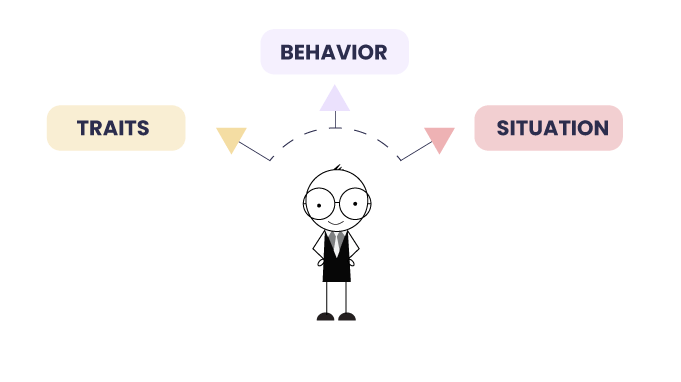
The contingency theory of leadership effectiveness states that leadership styles are dependent on the situation.
When determining distinct leadership styles, contingency theory highlights three main factors. They are as follows:
- Traits.
- Behavior.
- Situation.
Contingency theory emerged in the 1960s. It is founded on the principle that no single leadership style is appropriate for every circumstance.
The approach emphasizes the importance of -
- The leaders’ personality and,
- The situation in which that leader operates.
The contingency approach to management is multifaceted and has many implications. In support of this theory, various contingency models of leadership were developed.

What are the Different Contingency Leadership Models?
Fred Fiedler Contingency Model or LPC Contingency Model
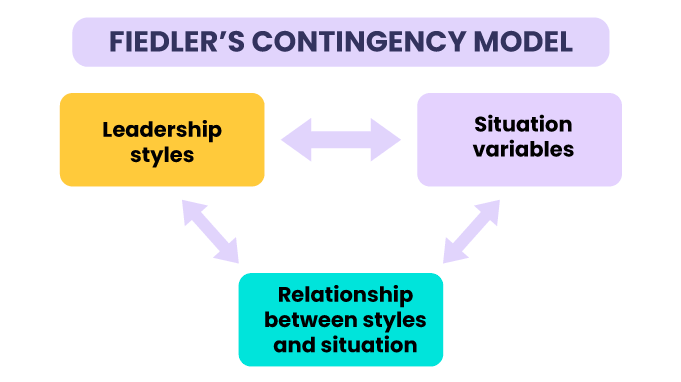
Fred Fiedler, in the 1960s, developed one of the first contingency theories. In Fiedler’s Contingency Theory, leadership styles are fixed.
You cannot change your style to suit the situation. Instead, it would be best if you put leaders into situations that match their style.
Fiedler’s Contingency Theory has two factors:
a) Leadership Style: In this factor, you determine your style of leadership. Fielder developed a scale called the least preferred co-worker scale (LPC).
The scale asks you to do the two simple things to understand your leadership style-
- Think about the person who you’ve least enjoyed working with.
- Then rate how you feel about this person for each factor and add up your scores.
According to this scale-
-
The more you rate the person you least like to work with, the more relationship-oriented you are. I.e, High LPC = Relationship-oriented leader.
-
The less you rate the person you like the least working with, the more task-oriented you are. I.e, Low LPC = Task-oriented leader.
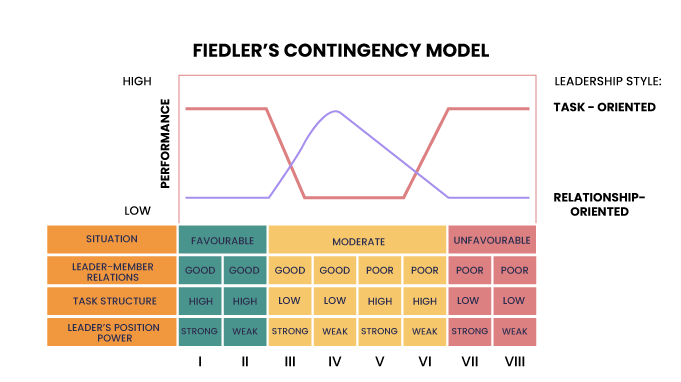
b) Situational favourableness: It is the second step that determines a particular situation’s favorableness. It depends on three distinct factors: -
Leader-Member Relations: This factor measures how much your team trusts you. Greater trust increases the favorableness of the situation, and less confidence reduces it.
-
Task Structure: This factor measures the task’s performance. It refers to the type of task you’re doing: clear and structured or vague and unstructured. Unstructured tasks are viewed unfavorably.
-
Leader’s Position Power: This is determined by the level of authority you display to reward or punish subordinates. The more ability you have, the more favorable your situation. Fiedler identifies power as being either strong or weak.
Criticism:
- One of the biggest criticisms is the lack of flexibility. Fiedler believed that an individual’s natural leadership style is fixed. Hence, the most effective way to handle situations is to replace the leader. He didn’t allow for flexibility in leaders.
- LPC scores can fail to reflect the personality traits they are supposed to reflect.
- The model’s validity has been disputed, despite many supportive tests.
- The model does not consider the percentage of in-between situations and unfavorable situations. A clear comparison between low-LPC leaders and high-LPC leaders is missing.

Situational Theory

Paul Hersey and Ken Blanchard developed the situational model in 1969. It was initially introduced as the “Life Cycle Theory of Leadership.” Later it was renamed “Situational Leadership Theory” in the mid-1970.
Like all contingency theories, Hersey Blanchard Situational Theory also focuses on the situation. Hersey and Blanchard concentrate on the characteristics of followers to determine leadership behaviors.
In this theory, Leadership style changes as per the follower’s ability and willingness. In 1977, Hersey and Blanchard both developed their divergent versions of this theory.
-
Blanchard’s Situational Leadership Theory: The semantics of Blanchard’s model used the word “Development.” He used words like “Directing,” “Coaching,” and “Supporting.”
-
Hersey’s Situational Leadership II Model (SLII Model): The semantics of Hersey’s model used Readiness or Maturity. He used words like ‘Telling,’ ‘Selling,’ and ‘Participating.’
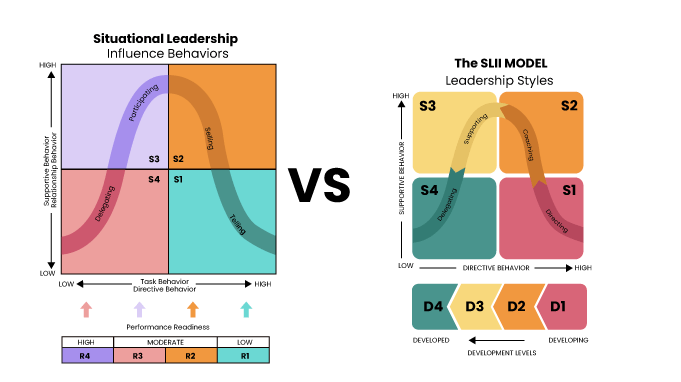
Situational Leadership Theory is a part of the two-factor theories of leadership-
a) Leadership style: Hersey and Blanchard characterized leadership style into four styles. They named each style S1 to S4. The titles for three of these styles differ depending on the version of the model.
The styles were characterized based on two behaviors-
- Task directive behavior and,
- Relationship or supportive behavior.
In the Hersey and Blanchard Situational Leadership Model (I):
| S1: Telling or Directing | S2: Selling or Coaching | S3: Participating or Supporting | S4: Delegating |
|---|---|---|---|
| The S1 leadership style puts high emphasis on directive behavior. This style has a soft focus on supportive behavior. | The S2 leadership style puts a high emphasis on directive and supportive behavior. | The S3 leadership style puts a high emphasis on supportive behavior. This style has a soft focus on directive behaviors. | The S4 leadership style puts low emphasis on both directive and supportive behaviors. |
| Individuals lack the specific skills required for the job at hand but are willing to work. They are novices but enthusiastic. | Individuals can perform various tasks. However, they are demotivated and unwilling to do their jobs. | Individuals are experienced. They can complete tasks but lack confidence and willingness to take on responsibility. | Individuals are experienced. They can perform tasks well. These individuals are willing to do jobs and also take responsibility for it. |
b) Individual or group's performance readiness level: As per Hersey and Blanchard, the right leadership style depends on the person or group being led.
Hersey and Blanchard situational leadership theory identified leadership styles into four maturity levels. They named them M1 to M4.
Maturity level is a measure of an individual’s ability and willingness to complete a task.
Blanchard’s Situational Leadership II makes some changes to the model. Blanchard’s Situational Leadership II relabelled the levels and considers development levels (D).
Development levels are considered to avoid stigma around the idea of immaturity. In Blanchard’s version, he names these levels D1 to D4 and slightly alters D1 and D2.
An individual’s development level is a combination of competence and commitment.
- Competence = level of skill, experience, knowledge, or behavior relating to a specific task.
- Commitment = motivation to learn a task and their confidence in their ability to learn.
In Blanchard's Situational Leadership model (II):
| High | Medium | Medium | Low |
|---|---|---|---|
| M4/ D4 | M3/ D3 | M2/ D1 | M1/ D2 |
| Competent and very willing (High competence and High commitment) | Capable but unwilling (High competence and Low commitment) | Unable but confident (Low competence and High commitment) | Incompetent and insecure (Low competence and Low commitment) |
| Followers are ready, able, and willing to perform. The followers are experienced at the required task. They are comfortable with their ability to do well. | Followers perform well on their tasks with a developed skill set. However, they are not willing to do so. | They are like M1 followers unable to perform a specific task, but they are willing to contrast. They are motivated to complete the job even though they lack specific skills. This follower style is often seen with new employees but lacks work experience. | Followers lack the necessary skills to perform well in tasks. They are also unwilling and lack the confidence to deliver the job needed. |
| Blanchard’s version of the Situational Leadership Model Competence and commitment are considered high. | In Blanchard’s version of the Situational Leadership Model, commitment is variable. It starts as low and gradually grows more significant. It increases due to more self-esteem and confidence until a follower reaches D4. | Blanchard decided to label this follower style with D1. D1 is the first stage of a follower’s development. As followers gain experience, they reach D2 and gain some competence. However, their commitment drops due to the complexity of tasks. Hence, Blanchard labels this follower style with D2 instead of D1. | Blanchard labeled this follower style with D2 instead of D1. He views this follower style as the second stage in a follower’s development. |
Criticism:
- This approach does not have a large body of research findings. It does not justify the approach’s assumptions and propositions.
- It is unclear how subordinates move from low to high development levels. It is also unclear how commitment changes over time for subordinates.
- The model does not address how demographic characteristics affect employees’ preferences for leadership.
- It does not highlight how leaders can use this model in group settings.
Path-Goal Theory

The path-goal theory was developed by Robert House, an Ohio State University graduate, in 1971. It was inspired by the work of Martin G. Evans (1970) and Victor Vroom’s expectancy theory of motivation (1964).
The model specifies the following statements-
-
Leaders should engage in different types of leadership behaviors.
-
Leadership style should best fit the working environment.
-
Leaders' behavior depends on the nature and the demands of a particular situation.
-
It is the leader’s job to assist followers in attaining goals.
-
Leaders should provide the direction and support needed by the followers.
-
Leaders should also ensure that their goals are compatible with the organization’s goals.
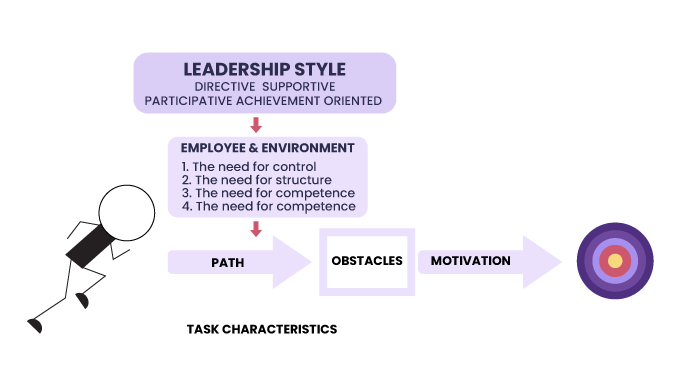
Path-Goal Theory is not a detailed process but generally follows three basic steps- -
Determine the employee and environmental characteristics.
-
Select a leadership style.
-
Focus on employee motivations that will help them succeed.
Path-Goal theory assumes that leaders are flexible. It believes that leaders can change their style as per different situations. The theory proposes two contingency variables-
- Environmental factors: It determines the type of leadership behavior needed to maximize performance.
- Employee characteristics: Employee characteristics determine the locus of control, experience, and ability. Personal factors of employees determine how the environment and leader are interpreted.
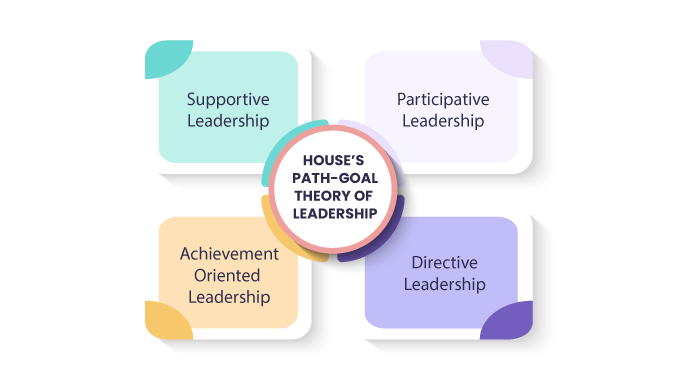
This theory identifies four leadership behaviors or styles-
- Achievement-oriented leader behavior: The leader sets challenging goals for their followers. They expect followers to perform at the highest level. They show confidence in their ability to meet expectations. This behavior is most effective in professional work environments such as sales environments.
- Directive-oriented leader behavior: The leader informs their followers on what is expected of them. Leaders tell the followers what to do, how to perform a task, and coordinate work. It is most effective when there is a lot of uncertainty within the environment.
- Participative leader behavior: The leader consults with their followers and asks for their suggestions before deciding. This behavior is predominant when employees are personally involved in their work. These kinds of leaders are more people-oriented than task-oriented.
- Supportive leader behavior: Leaders are directed towards the satisfaction of employees’ needs and preferences. This behavior is especially needed in distressing tasks or relationships.
Criticism:
- The theory leadership aspects it tries to incorporate are complex. The behavior, motivation, and process to apply the right leadership style are challenging.
- The theory lacks aempirical research.
- The path-goal theory fails to explain how leadership behavior correlates to followers’ motivation. The approach is only directed towards the followers. It removes the possibility of followers being able to affect change on leaders.
- The theory is complex. Hence, it is challenging to use it in every leadership scenario.
Leadership Substitutes Theory
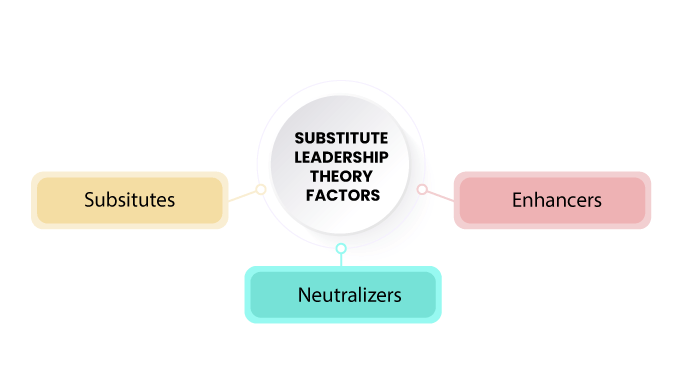
Steven Kerr and John M. Jermier (1978) proposed the substitutes for leadership theory. This theory has evolved from path-goal theory.
Leadership Substitutes Theory is a framework. It helps to interpret the contingent relationship between leadership behavior and the outcomes. Different situational factors can substitute, neutralize, or enhance leadership behaviors.
- Substitutes- Substitutes remove leaders’ controlling power and help group members increase their performance.
- Neutralizers- Neutralizers only remove influence from the leader. It serves to weaken or block leader influence on subordinate outcomes.
- Enhancer- Enhancers are variables that serve to strengthen leaders’ influence on subordinate outcomes.
Kerr and Jermier measured these substitutes using a questionnaire.
The questionnaire has the following characteristics:
- Thirteen subscales with 55 items.
- Subscale items are listed on a Likert scale rating.
- The LPC scale ranges from 1 (completely untrue) to 5 (almost always true).
Criticism:
- When interpreting the contingent relationships, independent and dependent variables are collected. The variables are managed by the same person, causing a common source of biases.
- The study focuses on relationships between variables for a specific time. It lacks involvement in various other measures over an extended period.
- The concept of this theory is weak. It is hard to identify specific substitutes and neutralizers for broad behavior categories.
Multiple-Linkage Model
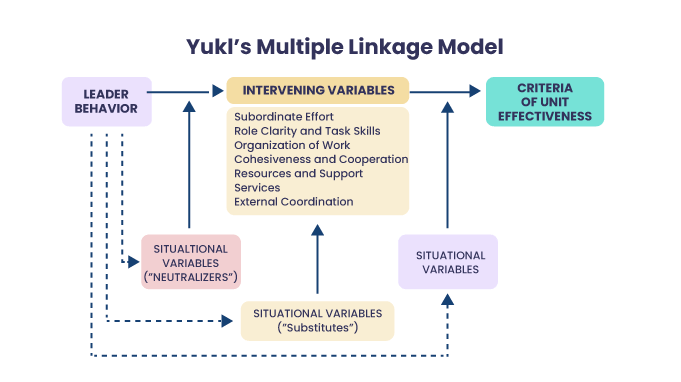
Gary Yukl developed the Multiple-Linkage Model in 1981. He proposed that the impact of leader behaviors on group performance is complex. The leader behaviors are composed of four variables-
- Managerial behaviors.
- Intervening variables.
- Criterion variables.
- Situational variables.
Good Leaders can influence the variables in several ways. These variables moderate the leader’s impact on group performance. However, the effects of leader behavior depend on the situation.
Intervening variables: Intervening variables consist of leaders’ behaviors that immediately affect employees’ job performance. A leader can influence subordinate performance by controlling the intervening variables.
Many variables of a leader’s behavior and situation correlate to subordinate performance.
Subordinate performance is dependent on four intervening variables:
- Ability to do the work.
- Task motivation.
- Clear and appropriate perceptions.
- Presence or absence of environmental constraints.
Work unit performance depends on six intervening variables:
- Member effort.
- Member ability.
- Organization of the work.
- Teamwork and cooperation.
- Availability of essential resources.
- External coordination with other parts of the organization.
Situational Variables: The situational variables that influence the follower effort are-
- Formal reward system and
- The intrinsically motivating properties of work.
In this model, two scenarios are possible-
- Intervening variables may be directly affected by situational characteristics.
- Situational variables may directly affect intervening variables.
The leader’s job is to correct deficiencies arising in the intervening variables. In the long term, the position of the leader is to improve situational factors.
Criticism:
- There are no clear claims about which leader behavior influences which situations.
- It is more of a general framework than a formal theory with precise recommendations.
- Very few studies confirm this theory.
Cognitive Resource Theory
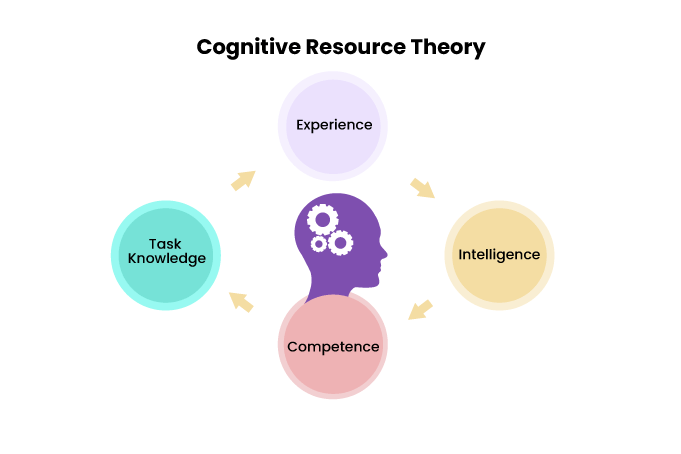
The Cognitive Resource Theory (CRT) is a situational model. It is a reevaluation of the Fred Fiedler contingency model. Joe Garcia and Fred Fiedler, in 1987, developed this theory.
The model has the following characteristics-
- The model deals with the cognitive abilities of leaders.
- The model considers personalities, the degree of situational stress, and group-leader relations.
- The Cognitive Resource Theory explores the conditions related to leadership effectiveness. Cognitive resources refer to experiences, intelligence, competence, and task-relevant knowledge.
- The cognitive resource theory expands upon the trait theory.
- The model includes situational variables when examining leader behavior.
- Leader traits are discussed regarding how they interact with situational variables.
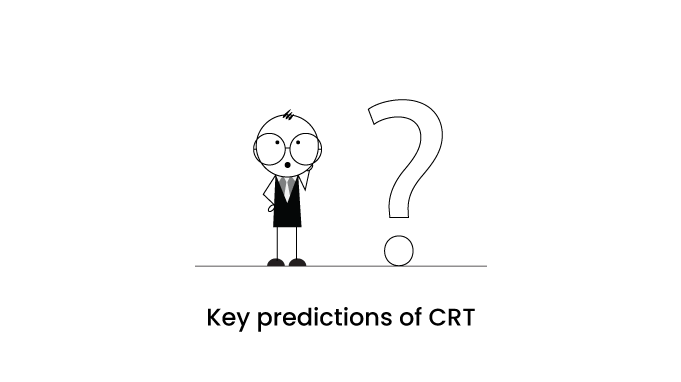
There are four predictions of this theory are-
- A leader’s cognitive ability contributes to team performance only in the case of directive leadership.
- Stress affects the relationship between intelligence and decision quality. Intelligence is helpful and contributes well when under pressure. Natural intelligence does not contribute and can even be detrimental under extreme stress.
- A leader’s abilities contribute to group performance only under certain conditions. Conditions include groups that favor the leader and support them and their goals.
- A leader’s intelligence correlates with the performance and degree of complexity of tasks.
There are several prepositions of cognitive resources theory:
- The first proposition is the leader’s ability to contribute to group performance. Leaders are directive when followers need guidance.
- Perceived stress influences the relation between intelligence and decision quality.
- Perceived stress moderates the relation between leader experience and performance.
Criticism:
- The theory is criticized due to the incorrectness in using factors, i.e., intelligence. It has ignored different intelligence types based on creativity, emotional intelligence, etc.
- The theory states the qualitative aspect of stress. There is no arrangement of the quantitative part of measuring employee stress.
- The theory didn’t define positive, negative stress types. Nor did it explain their impact on different leaders and leadership styles separately. A leader can be strong or weak based on different situations.
Normative Decision Theory
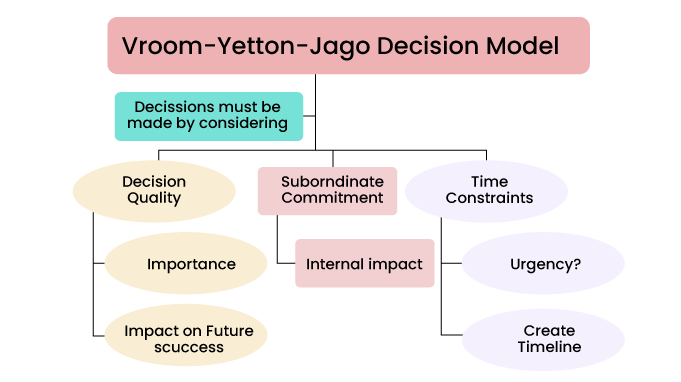
Victor Vroom and Phillip Yetton, in 1973, developed the normative decision theory. Arthur Jago later collaborated in 1988 to revise the normative decision model.
It helps to know how much employee involvement is necessary to make decisions. Unlike other leadership theories, the normative decision theory defines five different decision styles.
Vroom and Yetton specify decision effectiveness depending on two intervening variables:
- Decision quality: Decision quality is the aspect that affects group performance. However, group performance isn’t moderated by the effects of decision acceptance.
- Decision acceptance by followers: It is the degree of followers’ commitment to decisions.
Decision quality and decision acceptance gets affected due to the following variables-
-
Follower participation while making decisions.
-
The behavior used by the leader when making decisions.
-
The situation is also a key factor for decision quality and decision acceptance.
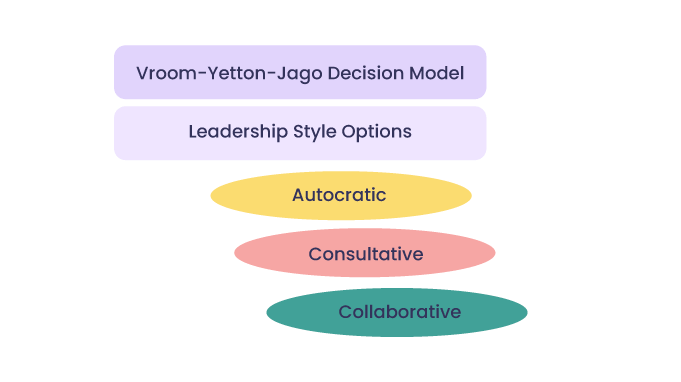
The model identifies five different styles based on the situation and level of involvement. Two are autocratic, two are varieties of consultation, and one is joint decision-making. -
Autocratic Type 1 (AI): The leader makes their own decisions. They use information that is currently available to them.
-
Autocratic Type 2 (AII): The leader collects the required information from followers, then makes the decision alone.
-
Consultative Type 1 (CI): The leader shares problems with relevant followers individually. They seek their ideas and suggestions but make decisions alone.
-
Consultative Type 2 (CII): The leader shares problems with followers as a group. They seek their ideas and suggestions and make decisions alone.
-
Group-based Type 2 (GII): Leaders discuss problems and situations with followers. They seek their ideas and suggestions through brainstorming. The decision accepted by the group is the final one.
Vroom and Yetton identified five aspects of the situation. These aspects mediate the effectiveness of the decision procedure, which relates to-
- Knowledge of relevant information.
- The degree to which followers are willing to cooperate in carrying out a mission.
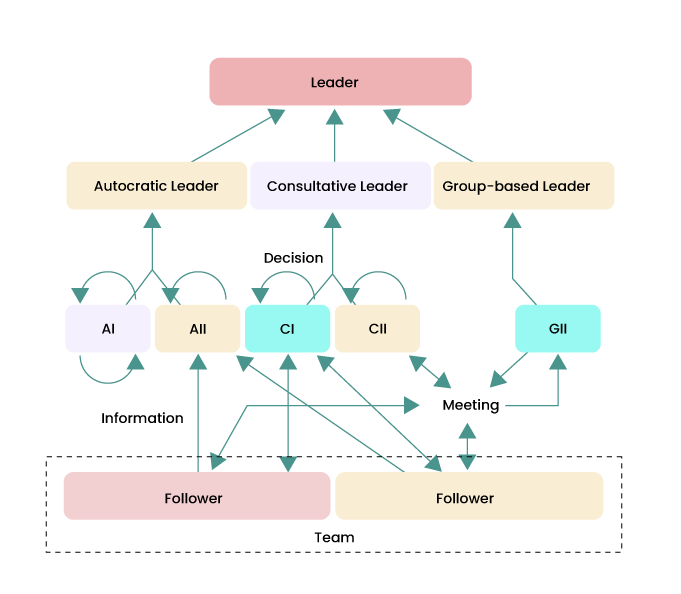
Vroom, Yetton, and Jago, in 1988, revised the model. They concluded the revised model by proposing seven basic questions.
These questions are on decision quality, commitment, problem information, and decision acceptance. These questions help to determine the level of follower’s involvement in decision-making.
The proposed questions of the revised model are as follows:
- Is the quality of the decision important?
- Is team commitment important for the decision?
- Do you have enough information to decide on your own?
- Is the problem well-structured?
- Would the team support your decision if you made it alone?
- Does the group share the organization’s goals?
- Is there likely to be conflict amongst the team over the decision?

Also, the new model suggests guidelines like-
- Time restraints
- Follower knowledge
- The geographical dispersion of followers.
Criticism:
- Automation of the model process is weak, and it lacks the personal factors of the leader.
- The questions used in the model may not be precise enough to reach ideal use.
- The Vroom-Yetton-Jago model may not work for a large team or group of people.
- The model ignores a leader’s orientation preference. It only considers the skills and willingness of followers.
Takeaway

Contingency theory is beneficial to organizations. It is helpful because of its potential for learning from specific situations.
The leadership lessons help to influence future management of the same or similar conditions. The ability to adapt to external pressures and changes is also an advantage.
The contingency theory approach is practical when integrated into organizational theory. The theory integrates various management approaches. It proposes that there is no one best way to organize or lead a company.
Several models attempt to understand the relationship between style and situation. These models help frame the contingency viewpoint among leaders.

















